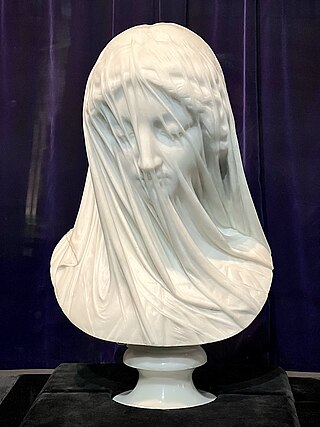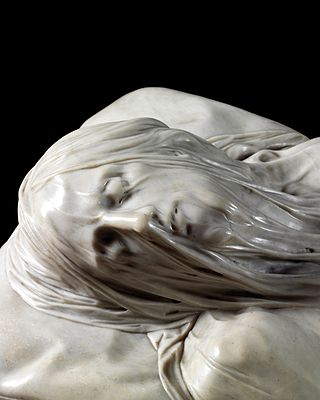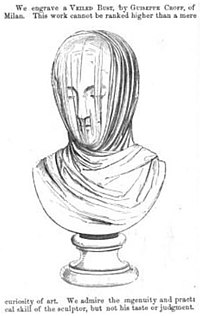
Thomas Ball was an American sculptor and musician. His work has had a marked influence on monumental art in the United States, especially in New England.

Hiram Powers was an American neoclassical sculptor. He was one of the first 19th-century American artists to gain an international reputation, largely based on his famous marble sculpture The Greek Slave.

Mary Edmonia Lewis, also known as "Wildfire", was an American sculptor.

Larkin Goldsmith Mead, Jr. was an American sculptor who worked in a neoclassical style.

The Veiled Virgin is a Carrara marble statue carved in Rome by Italian sculptor Giovanni Strazza (1818–1875) depicting the bust of a veiled Virgin Mary. The exact date of the statue's completion is unknown, but it was probably in the early 1850s. The veil gives the appearance of being translucent, but is carved of marble. The technique is similar to Giuseppe Sanmartino's 1753 statue Veiled Christ in the Cappella Sansevero in Naples.

Franzisca Bernadina Wilhelmina Elisabeth Ney was a German-American sculptor who spent the first half of her life and career in Europe, producing portraits of famous leaders such as Otto von Bismarck, Giuseppe Garibaldi and King George V of Hanover. At age 39, she immigrated to Texas with her husband, Edmund Montgomery, and became a pioneer in the development of art there. Among her most famous works during her Texas period were life-size marble figures of Sam Houston and Stephen F. Austin, commissions for the Texas State Capitol. A large group of her works are housed in the Elisabet Ney Museum, located in her home and studio in Austin. Other works can be found in the United States Capitol, the Smithsonian American Art Museum, and numerous collections in Germany.

Randolph Rogers was an American Neoclassical sculptor. An expatriate who lived most of his life in Italy, his works ranged from popular subjects to major commissions, including the Columbus Doors at the U.S. Capitol and American Civil War monuments.

Joseph Erhardy was an American sculptor.

Antonio Corradini was an Italian Rococo sculptor from Venice. He is best known for his illusory veiled depictions of the human body, where the contours of the face and body beneath the veil are discernible.

Raffaele Monti was an Italian sculptor, author and poet.

William Henry Rinehart was a noted American sculptor. He is considered "the last important American sculptor to work in the classical style."

Chauncey Bradley Ives was an American sculptor who worked primarily in the Neo-classic style. His best known works are the marble statues of Jonathan Trumbull and Roger Sherman enshrined in the National Statuary Hall Collection.

The Veiled Rebecca or The Veiled Rebekah is a 19th century sculpture carved out of marble in Italian neoclassical style by the sculptor Giovanni Maria Benzoni.The sculpture is also referred as The Veiled Lady in several records. It depicts a biblical figure of Rebecca placed on a marble pedestal.

Alexander Munro was a British sculptor of the Pre-Raphaelite movement. He concentrated on portraiture and statues, but is best known for his Rossetti-influenced figure-group Paolo and Francesca (1852), which has often been identified as the epitome of Pre-Raphaelite sculpture.

Veiled Christ is a carved marble sculpture completed in 1753 by the Neapolitan artist Giuseppe Sanmartino. It is formed from a single block of white marble, and was commissioned by Raimondo di Sangro, a prince of Sansevero, as the centerpiece of the Cappella Sansevero, in Naples, Italy.

George Washington is a marble bust portrait of George Washington, done in the style of a Roman emperor, by the Italian sculptor Giuseppe Ceracchi. It was created as part of a campaign by Ceracchi to build a larger monument to Washington. The bust was thought by many to be one of the most lifelike. It was later used as a model of Washington for works by other sculptors and engravers.

Palmyrene funerary reliefs are almost 4,000 busts on decorative slabs closing burial niches inside underground tombs, produced in Palmyra over three centuries from the middle of the first century BC. It is the largest corpus of portrait sculpture in the Roman world outside Rome and the largest collection of funerary representations from one place in the classical world.

Modesty or Chastity or Veiled Truth by Antonio Corradini is a sculpture completed in 1752 during the Rococo period. Corradini was commissioned by Raimondo di Sangro to sculpt a memorial for his mother in the Cappella Sansevero in Naples, where the marble sculpture still remains.

The Vestal Virgin Tuccia or Veiled Woman is a marble sculpture created in 1743 by Antonio Corradini, a Venetian Rococo sculptor known for his illusory depictions of female allegorical figures covered with veils that reveal the fine details of the forms beneath. The work is housed in the Palazzo Barberini, Rome.

The Veiled Vestal is an 1847 sculpture by Rafaelle Monti. It was commissioned by William Cavendish, 6th Duke of Devonshire during an 1846 trip to Naples. It is a representation of a Vestal Virgin, the priestesses of the Ancient Roman goddess Vesta. The subject was popular at this time due to the then recent discovery of the House of the Vestals in Pompeii. The depiction of translucent fabrics was popular at the time and Monti was requested to use the technique in this sculpture. Monti completed the sculpture in April 1847 and it was afterwards displayed at Cavendish's West London Chiswick House.




















